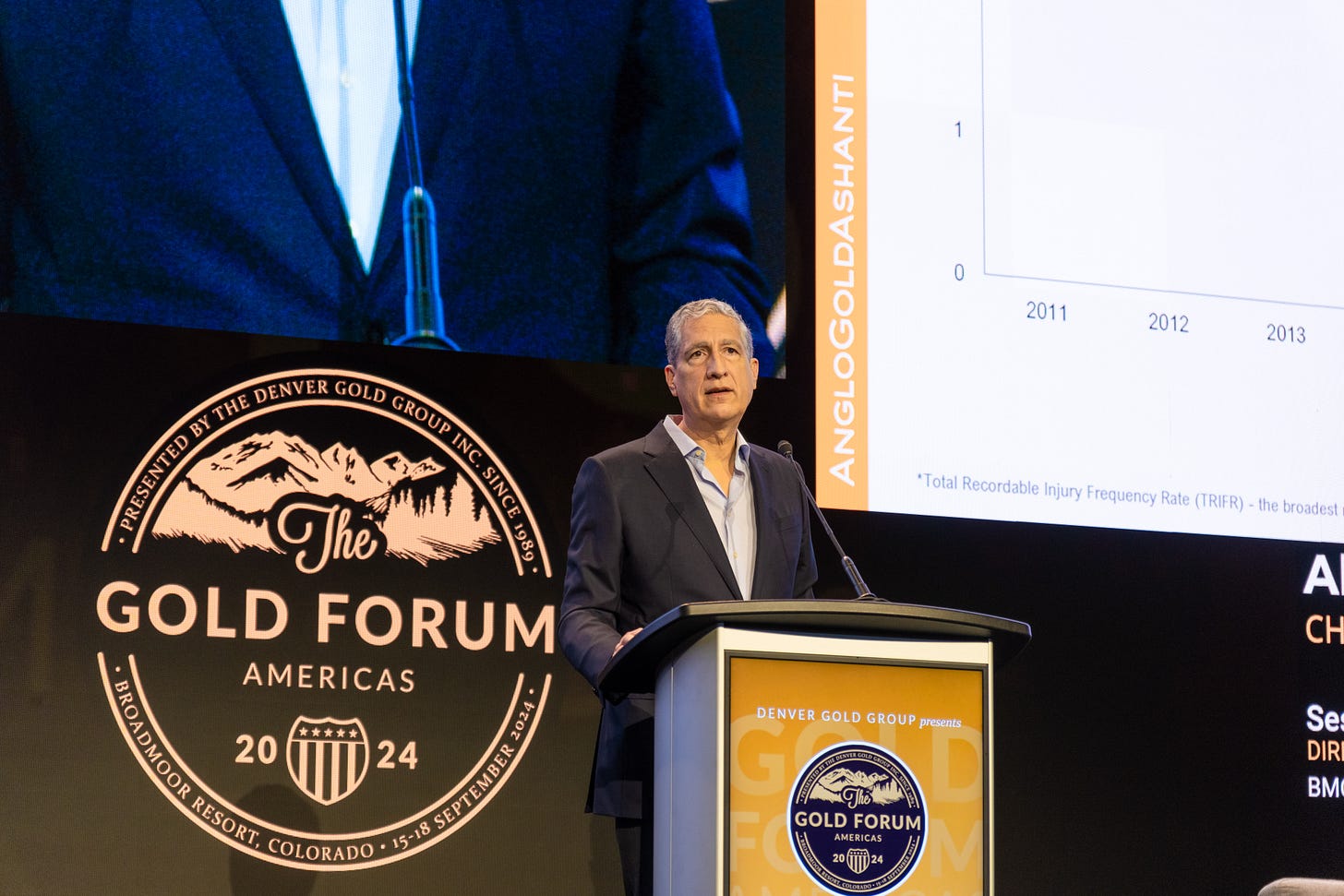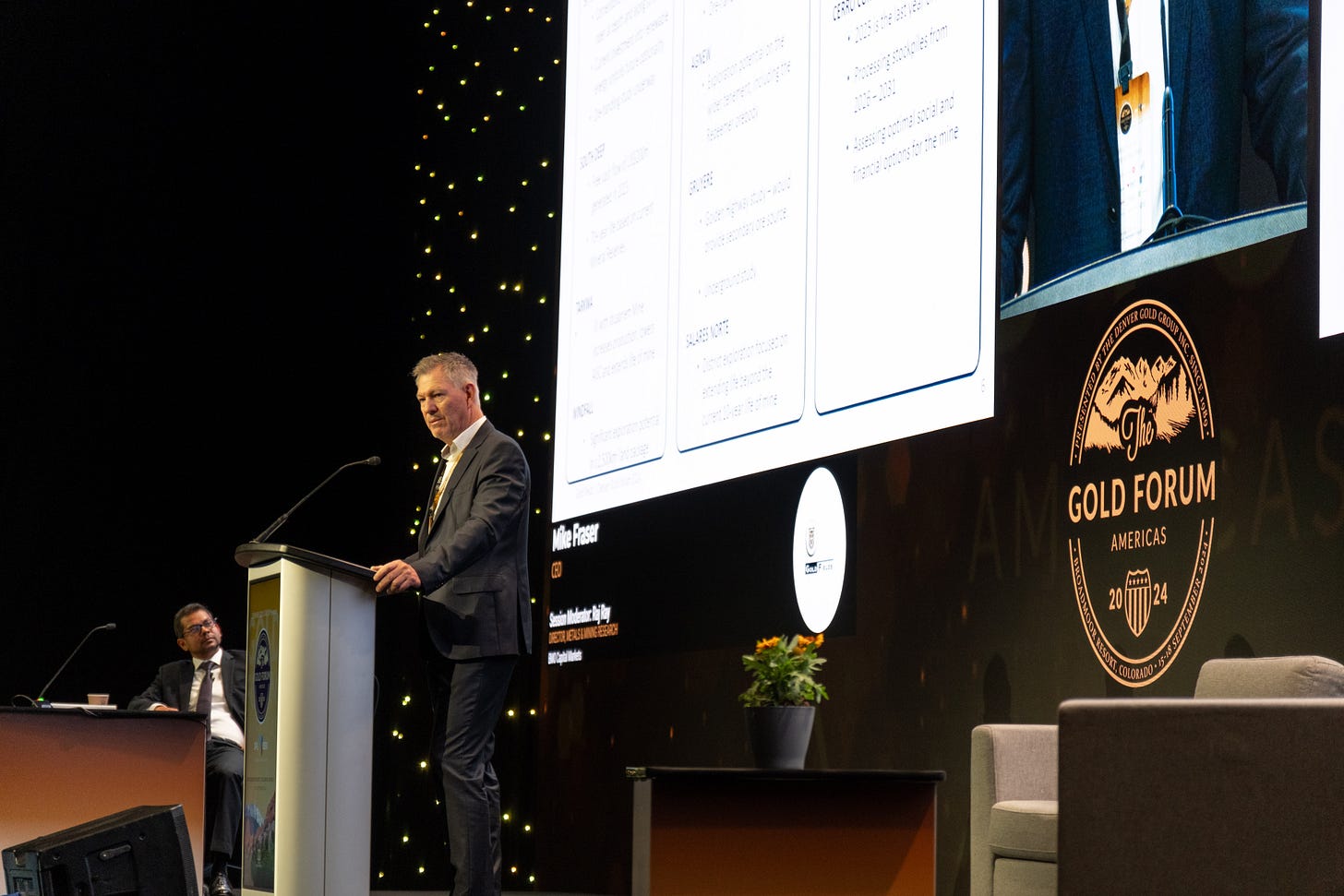What the majors said during the Gold Forum Americas’ super session
The world’s largest gold producers took centre stage on Tuesday morning at the Gold Forum Americas in Colorado Springs
AngloGold Ashanti
AngloGold Ashanti CEO Alberto Calderon kicked off the morning by reflecting on the company’s three-year journey to lower costs and improve the bottom line.
Calderon’s goal when he joined AngloGold was to create a more efficient company.
“I think the numbers show we’ve achieved this,” he said.
AngloGold’s Full Asset Potential program has realised benefits of US464 million.
The company’s all-in sustaining costs were previously around US$300 an ounce higher than its competitors.
“We have closed the gap and obviously that’s been reflected in the share price,” he said.
“We’re quite obsessed by this issue of costs.”
Last week, AngloGold announced the US$2.5 billion acquisition of Centamin, which will give it ownership of the Sukari gold mine in Egypt.
Calderon said once Sukari was included in the portfolio, two thirds of AngloGold’s production would come from tier one assets.
He said the company had looked at assets with a criteria of being tier one, having a good balance between risk and cost, which made Canada and Australia more difficult, and needed to add value on a net asset value basis.
“That’s quite difficult to do,” he said.
Calderon suggested the company may divest some of its tier two assets, which comprise Sunrise Dam, Siguiri, Cerro Vanguardia and Cuiaba.
Gold Fields
Gold Fields CEO Mike Fraser spruiked the company’s strong share price performance and balance sheet.
He said the company, which had two fatalities last year, was placing a heavy focus on resetting the safety culture.
“We believe safety is tied to good operating performance,” he said.
Since joining Gold Fields late last year, Fraser has worked on simplifying the operating model and updating the leadership team.
Fraser said there were misconceptions in the market that Gold Fields’ portfolio had short mine lives.
He pointed out that the company’s multi-decade assets included St Ives in Australia, South Deep in South Africa, Tarkwa in Ghana and Windfall in Canada.
The assets with upside optionality include Granny Smith, Gruyere and Agnew in Australia and the new Salares Norte mine in Chile.
Gold Fields’ mature assets, Damang and Cerro Corona, will be sustainably closed or divested.
Fraser said Gold Fields would look to create value through greenfields and brownfields exploration.
“We continue to look at opportunities for bolt-on M&A,” he said.
“When bolt-on opportunities come up we will continue to pursue them.”
Gold Fields recently announced the C$2.2 billion acquisition of Osisko Mining to give the company 100% of Windfall.
Fraser said Windfall had striking similarities to the St Ives mine in Australia.
“We will build that project with our own cash generation,” he said.
“We can create fundamental value, even at the price that we paid.”
Barrick Gold
Barrick CEO Mark Bristow opened his presentation by lamenting the industry’s “chronic underinvestment” in exploration, which had led to a dearth of new projects, “forcing companies into M&A”.
“And while we at Barrick are very alert to value accretive opportunities, which the growing pressure for consolidation may create, and we continue to look for any that will meet our stringent investment criteria, we have the rare luxury of doing so from an asset base that will support organic production growth well into the future,” he said.
Barrick has six tier one gold mines and is planning to double copper exposure by 2029.
The company sees potential for more than 500,000 ounces of gold per annum from the new 100%-owned Four Mile discovery in Nevada.
“It reminds me of those company making Carlin deposits of the past,” Bristow said.
“It’s a world-class asset in every sense and another tier one mine in the making.”
Barrick has underperformed its peers this year, a point that clearly frustrates Bristow.
“Nevada Gold Mines, on its own, should undoubtedly command the industry's highest valuation,” he said.
He said the combined value of Barrick’s 61.5% share in Nevada Gold Mines and copper assets alone was at least US$33.2 billion, almost all of Barrick’s US$36.5 billion market capitalization.
“So, ladies and gentlemen, in short, when you buy a Barrick today, you get a lot for free,” he said.
Agnico Eagle Mines
Agnico Eagle Mines has been the best performing senior gold producer this year, overtaking Barrick in terms of market cap.
CEO Ammar Al-Joundi used his presentation to explain how Agnico differed from its peers.
He stressed that Agnico was a regional gold miner.
“Most of our peers consider themselves and are, in fact, global mining companies. They will go anywhere in the world to build a mine, and that's fine. I get that. That's a good strategy, and they're good at it,” Al-Joundi said.
“Agnico, we're a little different. We won't go anywhere in the world. We will go only to regions that meet two very specific criteria. It's the same criteria we've had since 1957 and it works for us.”
The two criteria are geology, specifically the potential for multiple mines with decades of life, and political stability.
Al-Joundi said the three best regions in the world were Nevada, Western Australia and the Abitibi in Quebec.
The company is not in Nevada or WA but Al-Joundi said the company would like to be in WA.
“Western Australia is a fantastic place to mine for gold. We are in Australia. We like Australia. We're looking at Australia,” he said.
Al-Joundi said Agnico was focused on lowering costs as the gold price rose.
“And you know why? Because in the last 20 years, the industry hasn't done a good job in delivering the leverage,” he said.
“We've never been more focused on it, because if we want our investors to stay with us, and if we want the generalists to come in, we've got to control costs.”
Al-Joundi said Agnico would generate at least US$1.5 billion in net free cashflow this year.
“About 90% of that free cashflow is being returned to shareholders,” he said.
Newmont Corporation
Newmont’s presentation comprised a fireside chat, hosted by BMO Capital Markets analyst Raj Ray, with Newmont chief financial officer Karyn Ovelmen and chief operating officer Natascha Viljoen, both of who have joined the gold miner in the past year.
Viljoen described Newmont’s portfolio as a “total embarrassment of riches”.
“With its 11 tier one assets, soon to be 12 when we start up our Ahafo North project, we have a true opportunity to look at the enterprise and run these operations really, really well,” she said.
Ovelmen, who came from outside the mining sector, said she’d like to see more of a focus on return on invested capital in the industry.
“The industry has not done very well when it comes to return on invested capital and rateable returns through a cycle,” she said.
“I think it's an opportunity for us. We need to run our business well. We need to meet our guidance every quarter, every month, every year, but most importantly, from a capital allocation perspective, we need to put an economic lens in terms of how we want to run our portfolios with an eye towards that return on invested capital, truly creating economic value for our shareholders.”
Last week, Newmont announced the divestment of the Telfer mine and Havieron project in WA to Greatland Gold.
Ovelmen said the next divestment would be Akyem in Ghana, followed by the North American assets.
She said the company had received “tremendous” interest in the North American assets.
“We are into the second phase of that process, so due diligence and all of those activities are taking place now,” she said.
“We continue to expect to complete the entire divestiture program by the end of the first quarter of 2025 and we are still anticipating that that will result in approximately or greater than US$2 billion in proceeds.”
Ovelmen said Newmont had its “hands full” in terms of the assets it picked up through the acquisition of Newcrest Mining and would be focusing on optimising the portfolio and share buybacks, rather than M&A.
Zijin Mining
Zijin deputy president Shaoyang Shen said the Chinese major came from humble beginnings but now had more than 30 mines in 16 countries.
“Still a lot of people identify Zijin as a gold miner,” he said.
However, copper has become more important to group performance, comprising 47% of the 2023 gross profit of US$6.6 billion.
Gold accounted for a quarter of the profit.
Zijin produced 2.1Moz of gold last year and has set guidance at 2.3-2.4Moz this year.
“We’re aiming for 8% growth,” Shen said.
Shen said a point of difference between Zijin and its peers was that Zijin didn’t own “so-called tier one assets”.
“We have to work harder to achieve our targets,” he said.
Zijin produced 1Mt of copper last year, increasing to 1.1Mt this year.
The company now has seven large-scale copper mines in three countries.
“We’re also an emerging lithium producer with three projects under construction,” Shen said.







